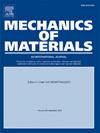凹衬底上纳米带的不稳定性
IF 3.4
3区 材料科学
Q2 MATERIALS SCIENCE, MULTIDISCIPLINARY
引用次数: 0
摘要
纳米带的不稳定性在传感器、光伏器件、储能等领域发挥着关键作用,引起了科学界和工业界的广泛关注。然而,纳米带在非平面基底上的不稳定行为尚不清楚,这阻碍了相关纳米器件的设计和开发。本文通过分子动力学模拟和理论分析,探讨了纳米带在凹球形衬底上的不稳定行为。研究发现,纳米带短边长度是决定临界起皱的关键参数。通过选择合适的短边长度、衬底半径和附着能,可以很好地调节材料的不稳定性。此外,本文还提出并验证了抑制凹衬底上纳米片不稳定性的可能策略,即将其尺寸减小到临界长度以下或引入拼接结构。本研究结果对于改善二维材料的不稳定性力学,并为各种纳米器件的设计和制造提供指导意义重大。本文章由计算机程序翻译,如有差异,请以英文原文为准。
Instability of nanoribbons on concave substrates
The instability of nanoribbons plays a key role in fields such as sensors, photovoltaic devices, energy storage, etc., thus attracting significant attentions of both scientific and industrial communities. However, the instability behavior of nanoribbons on non-flat substrates remains unclear, which hinders the design and development of related nanodevices. Herein, the instability behavior of nanoribbons on a concave spherical substrate is explored by molecular dynamics simulation and theoretical analysis. It is found that the length of short side of nanoribbon is the key parameter dominating critical wrinkling. The instability behavior can be well tuned through adopting suitable length of short side, substrate's radius and adhesion energy. Furthermore, possible strategies of inhibiting instability for nanosheets on concave substrates, i.e., reducing its size below the critical length or introducing splicing structures, are proposed and validated. The present findings should be of significant importance for improving instability mechanics of two-dimensional materials and providing guidance for the design and fabrication of various nanodevices.
求助全文
通过发布文献求助,成功后即可免费获取论文全文。
去求助
来源期刊

Mechanics of Materials
工程技术-材料科学:综合
CiteScore
7.60
自引率
5.10%
发文量
243
审稿时长
46 days
期刊介绍:
Mechanics of Materials is a forum for original scientific research on the flow, fracture, and general constitutive behavior of geophysical, geotechnical and technological materials, with balanced coverage of advanced technological and natural materials, with balanced coverage of theoretical, experimental, and field investigations. Of special concern are macroscopic predictions based on microscopic models, identification of microscopic structures from limited overall macroscopic data, experimental and field results that lead to fundamental understanding of the behavior of materials, and coordinated experimental and analytical investigations that culminate in theories with predictive quality.
 求助内容:
求助内容: 应助结果提醒方式:
应助结果提醒方式:


